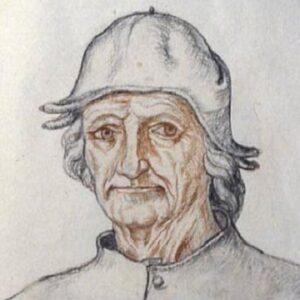During the Middle Ages, Hieronymus Bosch was a well-known Dutch painter and draftsman. Bosch, who was born in the Dutch province of Brabant, rose to prominence as one of the most important representatives of the Early Netherlandish Painting School. Through his works, he mostly depicted human flaws. His paintings, altarpieces, and triptychs (three-paneled paintings) were highly regarded, particularly by royals and nobles in numerous European countries, including the Netherlands. He used to get commissions to create clothing and stained glass, albeit most of them didn’t make it to the contemporary era. The triptych ‘Adoration of the Magi,’ which is currently located in the Prado Museum in Madrid, Spain, and another triptych ‘The Last Judgment,’ which is currently housed in the ‘Academy of Fine Arts’ in Vienna, Austria, are two of his most well-known works. His works continue to be extremely appreciated among wealthy customers in a number of European countries. The majority of his works are Christian in nature and deal with topics such as temptation, damnation, and the seven deadly sins. Even today, there are those who want to mimic his style.
Childhood and Adolescence
Hieronymus Bosch was born Jheronimus van Aken in the Dutch city of’s-Hertogenbosch in the province of Brabant. Although the exact year of his birth is unknown, he is thought to have been born about 1450. He did not leave behind any letters or diaries, thus little is known about his early life or parents.
His father, brother, and uncles were all artists, therefore he clearly hailed from an artistic background. His father was regarded as an artistic counselor to the ‘Illustrious Brotherhood of Our Blessed Lady,’ a popular Catholic organization at the time.
Career of Hieronymus Bosch
The artist spent the majority of his life in and around’s-Hertogenbosch. The city was thriving, and he had plenty of opportunity to make a name for himself as a painter. He was a gifted artist who had numerous commissions from all around the world. Much later, he took the name “Hieronymus Bosch” as his professional moniker.
Paintings of Hieronymus Bosch were done on oak panels. He worked with oil as his medium. His palette was minimal, with only the standard pigments of the day. The majority of his writings had a Christian aspect to them. Some academics believe that, while his works have received widespread acclaim, they are not very wonderful because they mainly reflected the religious views of his day. He also chastised those who waste their life pursuing worldly pleasures in some of his works.
He, like his father, became a member of the ‘Brotherhood of Our Blessed Lady’ around 1486. The Brotherhood is thought to have gotten him some of his first commissions. None of these early pieces, however, have survived to this day.
Despite the fact that he is thought to have painted a large number of noteworthy paintings throughout the course of his career, the exact number of his surviving works is still a point of contention, as his signature has only been found on seven of his surviving pieces. Because of the importance of his work, it is thought that several copies and modifications of his paintings were done by other painters. As a result, it’s still unclear whether all of the paintings credited to him were actually created by him.
Major Projects of Hieronymus Bosch
The ‘Adoration of the Magi,’ also known as ‘The Epiphany,’ is a triptych oil painting by Hieronymus Bosch that was painted somewhere between 1485 and 1500. It is currently on display at the Prado Museum in Madrid, Spain, which is the main Spanish National Art Museum.
The picture has been on display since 1839. The coat of arms of the Bronchorst, Kassembrood’s wife’s family, is depicted in the artwork. In the year 1568, Kasembrood was the secretary of a Spanish General named Lamoral, who was also hanged with him.
‘The Temptation of St Anthony’ is another of his masterpieces. The artwork depicts St Anthony the Abbot in meditation, in tranquil surroundings, and is currently displayed at the Prado Museum in Madrid, Spain.
‘The Last Judgment,’ a triptych, is another of his notable works. The painting was created after 1482 and is now housed in the Academy of Fine Arts in Vienna, Austria.
The Garden of Eden is depicted on the left panel, with God seated on his throne. It depicts Adam and Eve’s creation, as well as their subsequent expulsion after being seduced by the snake. The centre panel represents Christ passing judgment on the damned, while the final panel displays the damned souls being tortured even more.
Another of his well-known works is ‘Allegory of Gluttony and Lust.’ It was created between 1490 and 1500 and is now on display at the Yale University Art Gallery in New Haven, Connecticut. A big man rides a barrel in a small pool while being pushed around by other individuals, according to the painting. A swimmer’s wetsuit lies on the beach, and a pair is shown engaging in sexual acts inside a hut. The piece is seen as a criticism of gluttony and desire.
Personal History and Legacy
Hieronymus Bosch married Aleyt Goyaerts van den Meerveen, who was a few years his senior, around 1480. She was from an affluent family, and her marriage aided in his social advancement. The couple went to Oirschot, where his wife had received a house from her family, shortly after their marriage.
On August 9, 1516, Bosch died. In the Church of Saint John, he was laid to rest. He didn’t leave any protégés behind, but his best imitators were artists like Jan Mandyn and Pieter Huys.
Estimated Net Worth
Hieronymus Bosch was born on 1450 in Burgundian Netherlands, Dutch, is Painter. Hieronymus Bosch was a famous Dutch painter and his net worth is $11 Million


